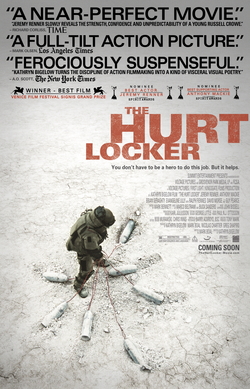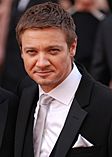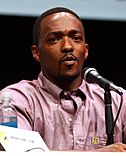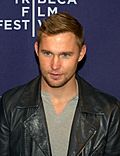The Hurt Locker facts for kids
Quick facts for kids The Hurt Locker |
|
|---|---|

Theatrical release poster
|
|
| Directed by | Kathryn Bigelow |
| Produced by |
|
| Written by | Mark Boal |
| Starring |
|
| Music by |
|
| Cinematography | Barry Ackroyd |
| Editing by |
|
| Studio |
|
| Distributed by | Summit Entertainment |
| Release date(s) | September 4, 2008 (65th Venice International Film Festival) June 26, 2009 (United States) |
| Running time | 131 minutes |
| Country | United States |
| Language | English |
| Budget | $15 million |
| Money made | $49.2 million |
The Hurt Locker is a 2008 American war thriller film directed by Kathryn Bigelow and written by Mark Boal. It stars Jeremy Renner, Anthony Mackie, and Brian Geraghty. The movie is about an Iraq War team that deals with bombs. It shows how the stress of their dangerous job affects them. The writer, Mark Boal, used his own experiences as a journalist working with soldiers to create the story.
The Hurt Locker was first shown at the Venice Film Festival in 2008. It was released in the United States in 2009. Critics really liked the film, praising the directing, acting, and exciting scenes. The movie won six Academy Awards (also known as Oscars), including Best Picture. Kathryn Bigelow became the first woman to win an Oscar for Best Director. The film earned $49.2 million around the world.
In 2020, The Hurt Locker was chosen to be kept in the United States National Film Registry. This means it's considered an important film for its cultural, historical, or artistic value.
Contents
What Happens in The Hurt Locker?
In 2004, Sergeant First Class William James joins a U.S. Army team in the Iraq War. This team is called the Explosive Ordnance Disposal (EOD) unit. Their job is to find and safely get rid of bombs. James takes over after their previous leader was killed by a bomb. His team includes Sergeant J. T. Sanborn and Specialist Owen Eldridge.
James often meets an Iraqi boy nicknamed "Beckham" who tries to sell him DVDs. James likes the boy and plays football with him.
Sanborn and Eldridge think James is too risky in how he handles bombs. This causes a lot of tension between them. One time, James goes back to a dangerous area to get his gloves. Sanborn even thinks about accidentally setting off explosives to get rid of James, but he doesn't.
While driving back to their base, the team meets five armed men. These men are private military contractors, like hired soldiers, from Britain. They have captured two prisoners. Suddenly, they all come under attack. The mercenary leader shoots the prisoners. Enemy snipers kill some of the mercenaries. James, Sanborn, and Eldridge fight back and kill some of the attackers.
Later, James finds a body he thinks is Beckham's. A bomb has been placed inside the body. During an evacuation, Lieutenant Colonel John Cambridge, a friend of Eldridge, is killed in an explosion. Eldridge feels guilty about it. James then searches an Iraqi professor's house, looking for revenge for Beckham, but finds nothing.
The team is called to a petrol tanker that might explode. James decides to look for the people who put the bomb there. Sanborn doesn't want to, but he and Eldridge follow James. Eldridge gets captured, but James and Sanborn rescue him. However, Eldridge gets shot in the leg by one of James's bullets. The next morning, James sees Beckham, who is alive and well. James walks past him silently. Before being taken for surgery, Eldridge blames James for his injury.
In their last two days of duty, James and Sanborn's team has another mission. An innocent Iraqi man has a bomb vest strapped to his chest. James tries to remove it, but there are too many locks. He has to leave the man, who is then killed when the bomb explodes. Sanborn is very upset. He tells James he can't handle the pressure anymore and wants to go home and have a son.
After his duty ends, James goes back home to his ex-wife and young son. But he finds civilian life boring. James tells his son that there's only one thing he truly loves. So, he starts another tour of duty, joining a new EOD team for another year.
Main Actors
- Jeremy Renner as Sergeant First Class William James
- Anthony Mackie as Sergeant J. T. Sanborn
- Brian Geraghty as Specialist Owen Eldridge
- Guy Pearce as Staff Sergeant Matthew Thompson
- Christian Camargo as Lieutenant Colonel John Cambridge
- David Morse as Colonel Reed
- Ralph Fiennes as the leader of a private military company
- Evangeline Lilly as Connie James
- Christopher Sayegh as Beckham
- Malcolm Barrett as Sergeant Foster
- Sam Spruell as Contractor Charlie
- Suhail Dabbach as a black-suit suicide bomber
How The Movie Was Made
The film was made with a small budget by independent filmmakers. It was directed by Kathryn Bigelow. The story was written by Mark Boal, a writer who spent time with a U.S. Army bomb disposal team in Iraq in 2004. This is called "embedded journalism," where a journalist lives with and reports on a military unit.
The movie was first shown at the Venice Film Festival in Italy in 2008. After being shown at the Toronto International Film Festival, a company called Summit Entertainment bought the rights to show it in the United States. The film was released in the U.S. on June 26, 2009.
Even though the film didn't make a lot of money right away, it won many awards. It was nominated for nine Oscars and won six. These included Best Picture and Best Director for Kathryn Bigelow. She was the first woman to win Best Director. Mark Boal also won for Best Original Screenplay.
Writing the Story
The Hurt Locker is based on the real experiences of Mark Boal. He was a journalist who spent two weeks with an American bomb squad in Iraq in 2004. Boal went with the soldiers many times a day to see their dangerous work. He emailed Kathryn Bigelow about what he saw. Boal used these experiences to write a fictional story that felt very real. He wanted to show what soldiers go through that you don't see on the news.
Bigelow was interested in understanding the minds of soldiers who choose to disarm bombs. These are people who run towards danger when everyone else is running away. She wanted the film to feel very real, like the audience was right there with the soldiers in their vehicle.
Choosing the Actors
Kathryn Bigelow chose actors who were not very famous for the main roles. She felt this made the movie more exciting because viewers wouldn't know what to expect from the characters. Jeremy Renner's character, Sergeant First Class William James, is a mix of different real people that writer Mark Boal met. To get ready for the movie, Renner spent a week training at a U.S. military base in California. He learned how to use explosives and how to wear a heavy bomb suit.
Anthony Mackie, who plays Sergeant J. T. Sanborn, talked about filming in Jordan during the summer. He said it was "desperately hot," which made everyone easily annoyed. But he felt the actors really supported each other, making it a great experience.
Many Iraqi refugees live in Jordan. Bigelow cast some of these refugees who had acting experience in the movie. For example, Suhail Dabbach plays the innocent man with the bomb vest at the end of the film.
Filming Locations and Challenges
The movie was filmed in Jordan, very close to the Iraqi border. This was done to make the film feel as real as possible. Iraqi refugees were used as extra actors. The cast and crew worked in the intense heat of the Middle East. The filmmakers first looked at Morocco, but Bigelow felt its cities didn't look like Baghdad. She wanted to be as close to the real war zone as she could. Some filming locations were less than three miles from the Iraqi border. Bigelow wanted to film in Iraq itself, but the security team couldn't promise their safety from snipers.
Filming started in July 2007 in Jordan and Kuwait. The temperature was often around 120 degrees Fahrenheit (49 degrees Celsius) during the 44 days of shooting. They often used four or more cameras at the same time, which resulted in almost 200 hours of footage.
The producer, Greg Shapiro, mentioned that people were worried about filming in Jordan. Bigelow said that many people in America had wrong ideas about the region. She explained that once you arrive, you realize it's a modern place. She believed that Jordan was the natural place to film movies about the conflict in Iraq.
Actor Jeremy Renner got sick with food poisoning and lost 15 pounds in three days. The bomb suit he had to wear all day weighed between 80 and 100 pounds (36-45 kg). In one scene, Renner fell down stairs and twisted his ankle, which stopped filming for a while.
The film's special effects artist, Richard Stutsman, used Chinese fireworks for gunpowder because it was hard to import military props. One day, the heat caused the fireworks to explode in his face, but he returned to work two days later. The film set didn't have many fancy things like air-conditioned trailers. Renner said they took great care to make the film feel real. He even said they were shot at a few times while filming.
Anthony Mackie said that the extreme heat and having Iraqi refugees as extras made the movie feel more real. He felt that hearing stories from people who were actually there helped the artists understand the story better.
How it was Filmed
Director Bigelow wanted to make the audience feel like they were right in the middle of the action. She was impressed with cinematographer Barry Ackroyd's work on other films. Bigelow used four Super 16 mm cameras to film from many different angles. She said this helps show both the small details and the bigger picture at the same time, making the audience feel completely involved. Using multiple cameras also helped her capture every part of the action scenes.
Movie Release
First Showings
The Hurt Locker was first shown at the Venice International Film Festival on September 4, 2008. The audience gave it a 10-minute standing ovation. At the festival, the film won several awards. It was also shown at the Toronto International Film Festival where it got a lot of attention. However, distributors were careful about buying it because other movies about the Iraq War hadn't done well. Still, Summit Entertainment bought the film for distribution in the United States.
The movie was also shown at many other film festivals around the world in 2008 and 2009.
Showing in Theaters
The Hurt Locker was first released in Italy on October 10, 2008. Summit Entertainment then released it in the United States on June 26, 2009, in a few theaters in Los Angeles and New York City. It earned a good amount of money for each theater it was shown in. The film slowly moved into the top 20 box office charts, even though it was playing in far fewer theaters than bigger movies. Summit Entertainment showed the film in more theaters in July 2009.
The movie earned $17 million in the United States and Canada, and over $32 million in other countries. This brought its total worldwide earnings to over $49 million. This was a good result, especially since its budget was $15 million.
The Hurt Locker did better than most other recent movies about conflicts in the Middle East. It earned more than films like In the Valley of Elah and Stop-Loss.
It's interesting to note that The Hurt Locker is one of only a few Best Picture Oscar winners that never made it into the top 5 or even top 10 movies at the weekend box office.
Watching at Home
The Hurt Locker was released on DVD and Blu-ray in North America on January 12, 2010. The DVD included comments from the director and writer, photos from filming, and a short video about making the movie in Jordan. By mid-August 2010, DVD sales in the U.S. had reached over $30 million. In 2022, a 4K version of the movie was released.
Images for kids
See also
 In Spanish: The Hurt Locker para niños
In Spanish: The Hurt Locker para niños







